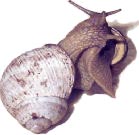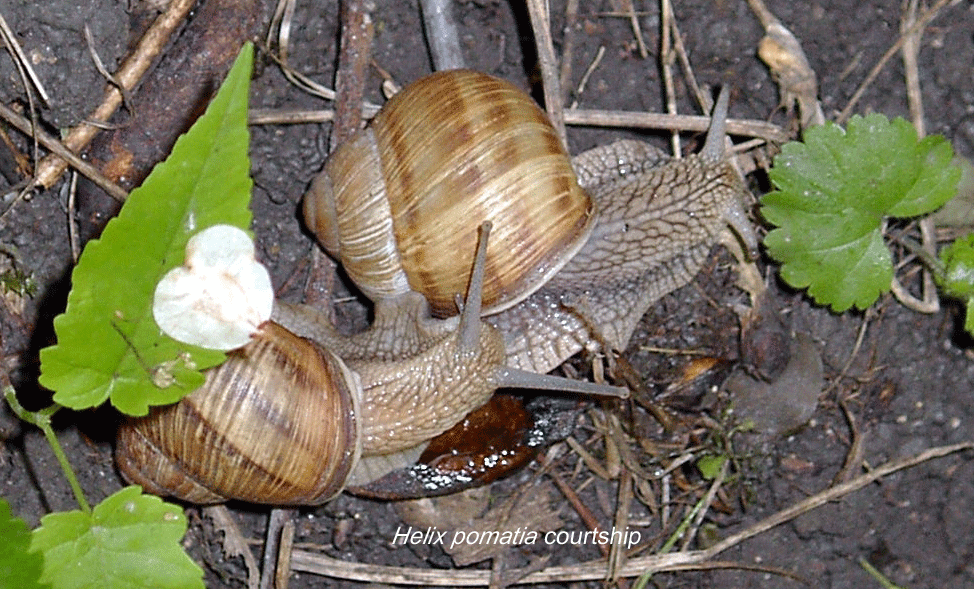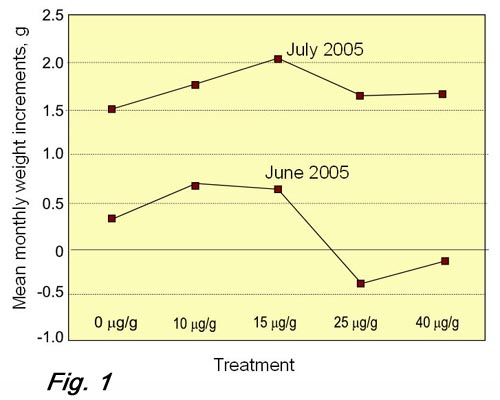

Effect of mineral dietary supplements on growth patterns of Helix pomatia 
by Nadejda Andreev, Institute of Zoology, Moldova Academy of Sciences
In many countries of Europe, the Roman snail Helix pomatia is highly appreciated as food, but this has led to the depletion of natural populations of this species. In Moldova, exploitation of this species started in the 90s and has lead to a decline in their populations in the wild due to poor management and control of collecting1. The species has attracted the attention of many snail farmers, but they are discouraged by its poor recruitment rate, longer time to reach maturity and higher production costs, compared to Helix aspersa. Considering the status of this species in Europe, a thorough study to improve rearing technology is very important.
 My
research looked for effects of dietary supplements of copper, zinc and
manganese on growth of the shell and body weight of juveniles of Helix
pomatia under laboratory conditions. Trace elements are important components of enzymes, vitamins
and hormones and participate in many metabolic processes. Either an
excess or a deficiency of trace elements can impair the growth and development
of animals and their resistance to disease. The trace elements Zn, I,
Cu, Co and Mn are particularly important, as are complex mixtures such
as Cu+Zn+Mn. By their participation in biological catalysis and metabolism,
manganese and zinc have a regulatory effect on growth and reproduction
in animals and humans, while copper has multiple roles.
My
research looked for effects of dietary supplements of copper, zinc and
manganese on growth of the shell and body weight of juveniles of Helix
pomatia under laboratory conditions. Trace elements are important components of enzymes, vitamins
and hormones and participate in many metabolic processes. Either an
excess or a deficiency of trace elements can impair the growth and development
of animals and their resistance to disease. The trace elements Zn, I,
Cu, Co and Mn are particularly important, as are complex mixtures such
as Cu+Zn+Mn. By their participation in biological catalysis and metabolism,
manganese and zinc have a regulatory effect on growth and reproduction
in animals and humans, while copper has multiple roles.
The snails were fed twice a week on chopped burdock leaves (Arctium lappa) on which was spread a mixture of Cu+Zn+Mn at 0, 10, 15, 25 or 40 µg/g, prepared from CuSO4, MnCl2 and ZnSO4 in a moistened dry food. The dry food consisted of wheat flour (40 %), soya meal (20%), calcium carbonate (30 %), calcium phosphate (5%) and sunflower seeds (5%). This was eaten readily by both adults and juveniles. Humidity was increased with a hand sprinkler, and dry branches were placed in the containers to provide shade and maintain humidity. The top of the glass containers were covered with mosquito net.
In the first experiment, which started in mid-July 2004, egg-laying of adults was to have been investigated, and five groups of 10 adult snails were placed in glass containers, with a soil containing 4.1-4.2 % calcium, which is suitable for snail rearing. However, no snail from any group laid eggs over a period of three weeks. I assume that the snails were collected too late from nature, after they had already laid eggs. So, in mid-August, I turned my attention to juvenile snails. In a pilot experiment, five groups of 12 juveniles were placed into the glass containers and fed on the same food composition. However, the concentrations of (Cu+Zn+Mn) given in these pilot trials were much higher than those used with adults and many snails died. Therefore fresh juveniles were collected and exposed to the same concentration ranges as the adults.
The juvenile snails were divided randomly into 10 snails in each of five containers and fed on food enriched with (Cu+Zn+Mn) at concentrations of 0, 10, 15, 25 or 40 µg/g. The experiments continued until late October, when the snails stopped feeding and entered into hibernation, and resumed the following spring, after the end of hibernation. Weight and shell size were at first measured each two weeks and then monthly. If an animal died, it was removed and a similarly sized snail was also removed from each of the other containers, so that density in each container was the same. Two snails chosen at random from each treatment were removed after two weeks and a further two at the end of the experiment. These were killed, dried and ground up for later trace element analysis, together with samples from the flour and the burdock leaves.
The experiments were repeated in 2005 on juveniles collected from a snail farm.
 During October, when
snails stopped feeding, and through the hibernation period until May,
all groups lost weight. During
June, all groups showed an increase in the body weight, but in July
the snails exposed to the two higher concentrations showed a decrease,
while those exposed to the lower two concentrations still showed faster
growth than the controls (Figure 1). These effects were also reflected
in shell width. In fish, positive effects on growth have been reported
from all these concentrations, but in Helix pomatia the higher
concentrations appear to inhibit growth.
During October, when
snails stopped feeding, and through the hibernation period until May,
all groups lost weight. During
June, all groups showed an increase in the body weight, but in July
the snails exposed to the two higher concentrations showed a decrease,
while those exposed to the lower two concentrations still showed faster
growth than the controls (Figure 1). These effects were also reflected
in shell width. In fish, positive effects on growth have been reported
from all these concentrations, but in Helix pomatia the higher
concentrations appear to inhibit growth.
These experiments are continuing with the juveniles from the snail farm, and will be interpreted in the light of analysis of trace element content in snail tissues, prior to preparing a manuscript for publication. I am grateful to Prof. Elena Zubcov, Head of the Laboratory of Hydrobiology and Ecotoxicology at the Institute, for her supervision, and to Nina Boichenco and Zinaida Bogonin for their assistance with the laboratory experiments. I extend my thanks to the officers of the Malacological Society of London for advice and encouragement and to The Society for financial support through a Centenary Research Grant.
1 Andreev N. (in press) Assessment of the status of wild populations of land snail (escargot) Helix pomatia L. in Moldova: the effect of exploitation. Biodiversity and Conservation